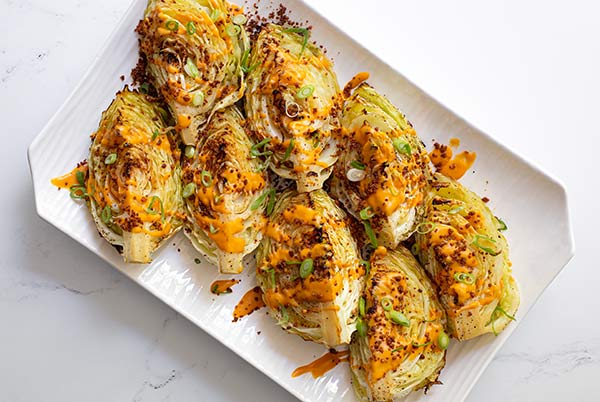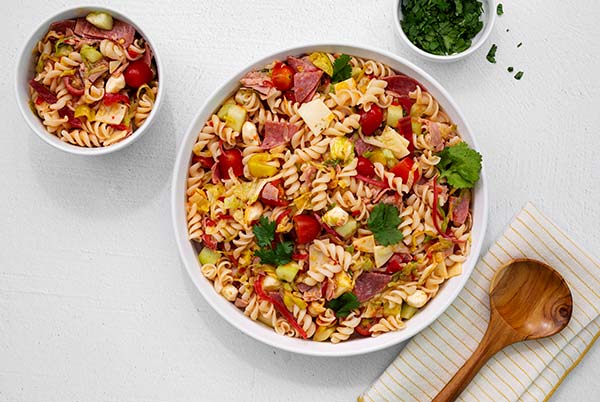This sweet, buttery gluten free shortcrust pastry is light, flaky, and melts in your mouth. Perfect for making tarts!

Gluten free shortcrust pastry, similar to pie dough, is made with simple gluten free pantry ingredients like an all purpose gluten free flour blend, cold chopped butter, and water, plus an egg yolk for richness. It helps make this shortcrust crumblier and melt-in-your-mouth delicious.

Why you’ll love this gluten free shortcrust pastry recipe
This recipe for shortcrust pastry is a special, basic recipe that you’re going to be able to use for so many things (including my gluten free fruit tart recipe). Here’s what makes it special:
- Easy to handle
- Rolls out smoothly
- Made entirely by hand (no stand mixer or food processor required)
- Rich and buttery, but not heavy and doesn’t compete with whatever filling you use
- Can be used for no-bake fillings like our no bake cheesecake or with a baked filling like our gluten free chocolate chip pie
The ingredients you’ll need
- All purpose gluten free flour blend: I really like my Better Than Cup4Cup blend here, or Nicole’s Best, but you can use Better Batter or Cup4Cup with great results. This is a very simple recipe, and although the flour blend always matters, it matters even more in a simple recipe that’s all about texture, so be sure to use one of my recommended blends.
- Xanthan gum: You must use some xanthan gum or your dough simply won’t roll out smoothly and won’t stay together without cracking. If your blend already contains xanthan gum, omit this ingredient.
- Confectioners’ sugar: Confectioners’ sugar is finely ground sugar with a touch of added starch to make it smooth, and it adds sweetness without adding any weight. Make sure you sift it, though, or you’ll find little clumps of it in your pastry.
- Kosher salt: Salt brightens the buttery flavor and balances the gentle sweetness. Kosher salt or lightly flaked sea salt are my go-to salts since they’re easy to measure—and harder to overmeasure than table salt.
- Unsalted butter: Butter provides richness, adds flakiness, and of course a buttery smooth flavor. Make sure you keep yours cold so that it expands in the oven, creating flakiness
- Cold water: We use cold water, with ice to keep it chilly, to hydrate the dough properly—but we don’t add the ice to the mixing bowl. Be sure to strain it out as you pour.
- Egg yolk: We add a single egg yolk to this recipe for richness. It also makes the dough a bit more crumbly (in a good way!) so it melts in your mouth.
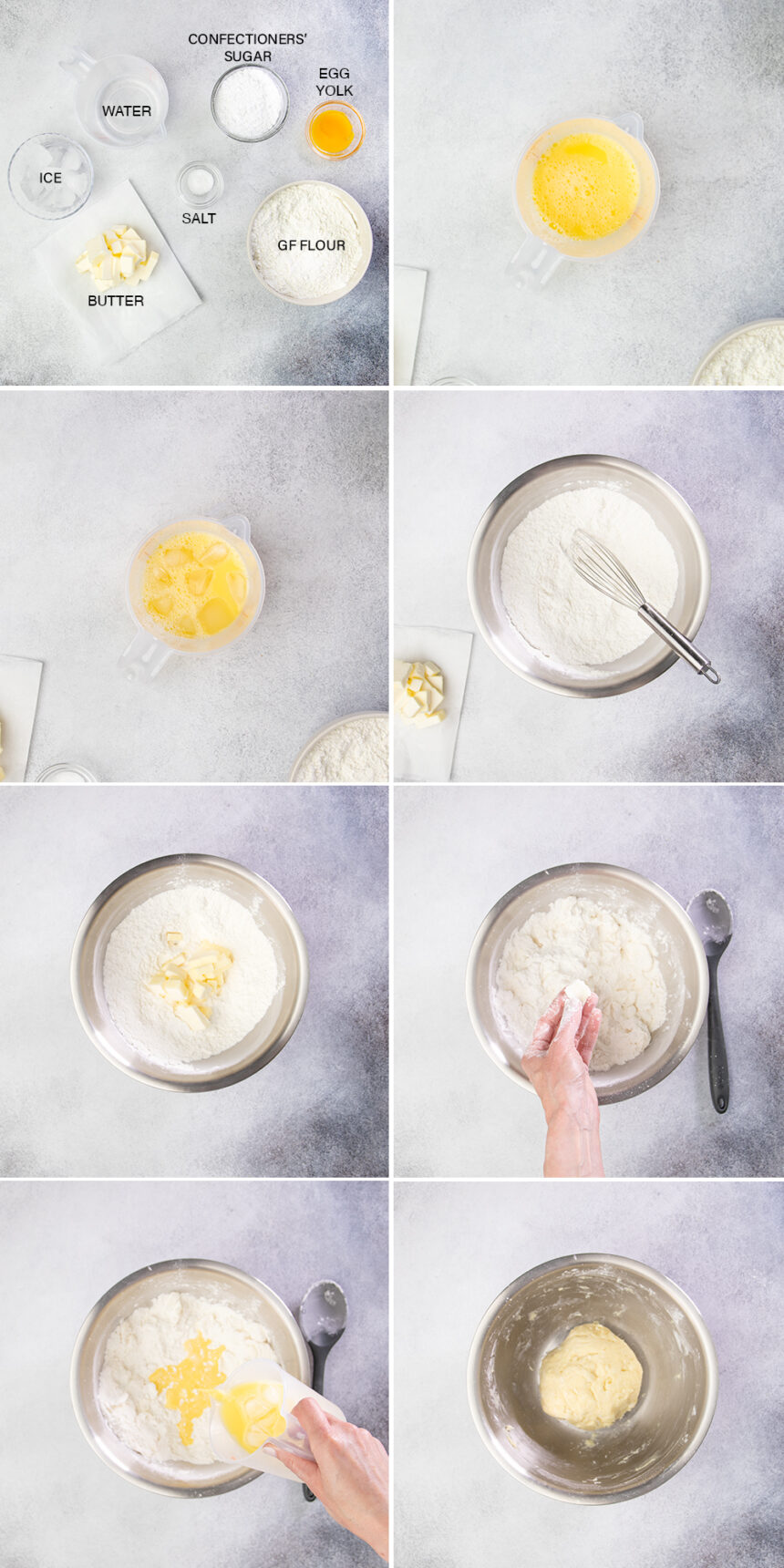
How to make gluten free shortcrust pastry
This pastry dough is made in a similar way to how we make most gluten free pastries: by whisking together dry ingredients, cutting in chunks of cold butter, and adding liquid to bring everything together. Here’s how:
- In a 1 1/2 to 2 cup measuring cup (or small bowl), whisk together the cold water with the egg yolks. Add some ice to keep it cold, and set the mixture aside.
- In a large bowl, whisk together place the flour blend (including xanthan gum), sifted confectioners’ sugar, and salt.
- Add cold, chopped butter to the dry ingredients, and toss so each piece of butter is coated in flour.
- Press each floured chunk of butter between a floured thumb and forefinger to flatten it into a shard.
- Create a well in the center of the large bowl of dry ingredients, and add the egg yolk and water mixture. Mix to bring the dough together.
- If there are any very crumbly bits, add more ice water by the half-teaspoon, and mix to combine.
- Knead the dough together lightly just enough to press it into a disk.
- Press the dough into a disk and cover tightly with plastic wrap.
- Refrigerate for at least 2 hours or up to overnight.
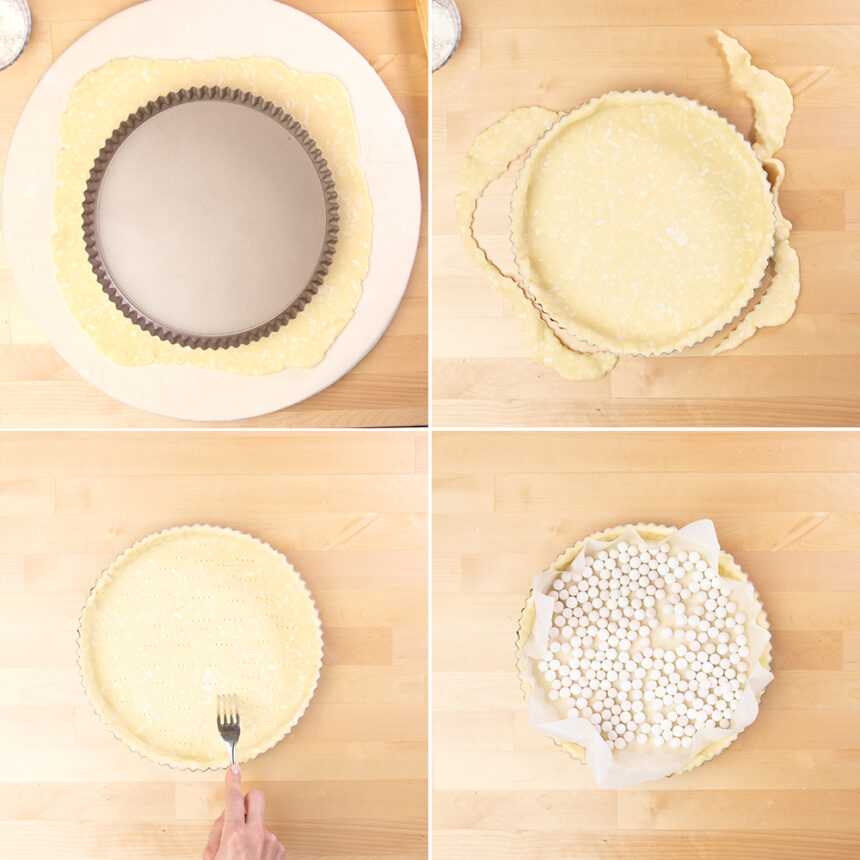
How to shape and bake gluten free shortcrust pastry
The process of shaping and baking a shortcrust pastry is very similar to the process of baking a pie crust. The same principles of keeping the ingredients cold, handling everything quickly, and using a light touch also apply. Here’s how:
- Sprinkle a flat surface lightly with more flour. Unwrap the dough, place it on the surface, and dust again lightly with more flour.
- Using a rolling pin (the kind with the two tapered ends and no handles is best), roll out the dough into a rough rectangle that’s about 1/2-inch thick rectangle.
- Fold the rectangle in half lengthwise, then dust it again lightly with flour, and roll it out again into a 1/2-inch thick rectangle.
- Once more, fold the rectangle in half lengthwise, and then fold again widthwise to create a thick square.
- Dust the square lightly with flour, and roll the dough out into a round that is about 2 inches larger in diameter than the tart pan you have chosen.
- If you’re using this dough to make small tartlets, as small as 4-inches, cut out 5-inch rounds using a biscuit or cookie cutter.
- To make a single full-size round tart, transfer the round of dough to the prepared tart pan. Press it gently into the bottom and the sides of the pan.
- Using a sharp knife or kitchen shears, trim the edges of the dough flush with the upper edge of the sides of the pan.
- Pierce the bottom and sides of the tart crust with the tines of a fork about 25 times. This will help keep the tart from puffing up in the oven.
- If you have the egg white from the egg yolk you used, use it to brush the bottom surface of the crust generously.
- Line the pastry crust with a piece of parchment paper, and cover the bottom of the crust with dried beans or ceramic or other heat-safe pie weights.
- Bake for 20 minutes at 375°F, then reduce the oven temperature to 350°F.
- Remove the crust from the oven, remove the paper and the pie weights, and return to the oven to bake for another 10 minutes or until the crust is not shiny and is dry to the touch.
- It should be pale golden brown all over with some darker brown patches.
- Allow the tart crust to cool fully before filling.
- If you plan to use this to make a baked filling, bake only for the first 20 minutes, remove the crust lining and weights, fill, and then return the crust to the oven to finish baking.
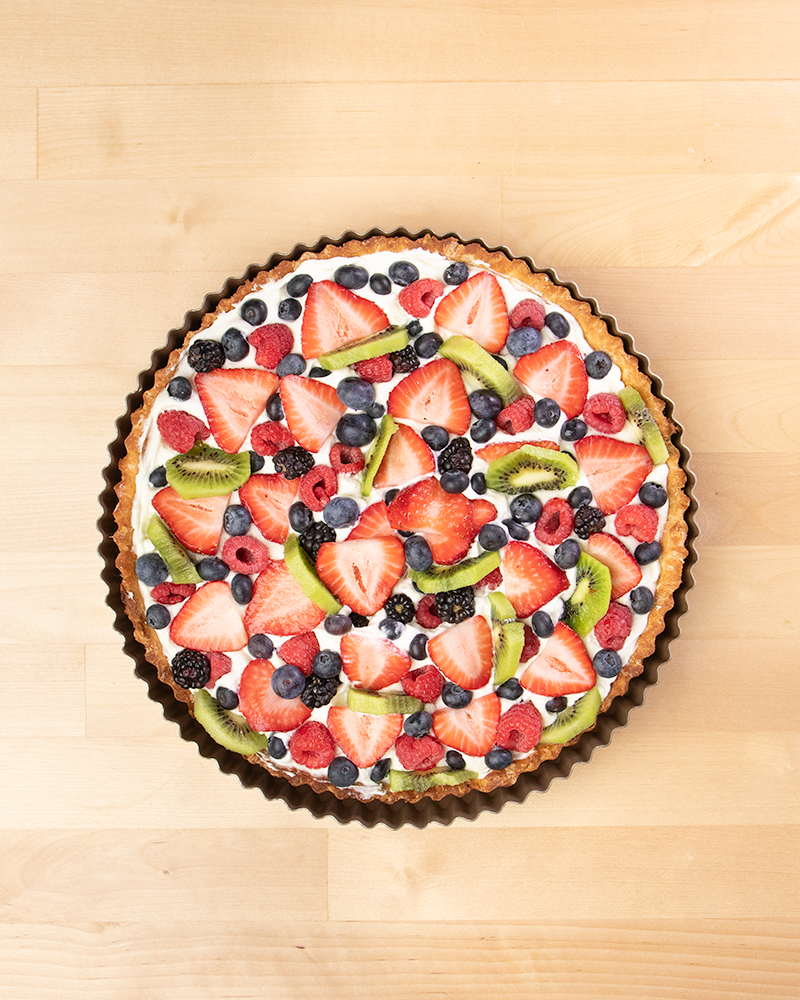
Gluten Free Shortcrust Tips & Tricks
Remember to keep everything cold
In making shortcrust pastry, like in most pastries, temperature matters a ton. Be sure to keep your butter cold, and your water cold. The egg yolk blends more easily into the cold water if it’s at room temperature, but it’s fine if that’s cold, too.
Only add more water if absolutely necessary
Begin with 3/8 cup (or 3 fluid ounces) of cold water, and since you’re mixing the egg yolk into it, you’ll add the whole volume to your flour mixture. But adding more water is strictly on an as-absolutely-necessary basis. If you see crumbly bits, try to add the extra water directly to those crumbly bits to moisten them.
If you do find that your dough seems wet and overly soft, don’t add more flour just yet. Wrap it tightly in plastic wrap and let it chill for at least 2 hours, and if possible overnight. That will give the flour a chance to absorb some of that extra moisture. If the dough is still tacky to the touch (you touch it and it leaves a residue on your finger), just sprinkle some extra gluten free flour on it as you’re rolling it out and it should tighten right up.
Avoid the food processor if you can
This gluten free shortcrust pastry is really best when made by hand. It allows you to keep the chunks of butter larger and more irregular, which makes for a lighter pastry. You can also more easily avoid adding too much liquid when you do it by hand.
If you are just more comfortable using a food processor, be sure to pulse lightly, and at least consider adding the water and yolk mixture by hand. That way, you really get a feel for how much moisture the dough needs.
If your shortcrust pastry cracks
Since we go through a few rounds of rolling out the dough, folding it into a rectangle, and rolling it out again, the dough should be pretty smooth by the time you’re creating your final shape. If the dough seems oily, that means that the butter has melted and your best bet is to wrap it tightly and chill it right away.
If you find that it’s cracking like it’s too dry and the dough isn’t holding together properly, sprinkle it lightly with water (literally, sprinkle it with water from your fingertips) and press and roll the dough back together. If the dough hasn’t cracked, but instead really has just torn, fold it over on itself, then roll it out again and proceed as if nothing ever happened!

If you like shortcrust pastry, you may also be interested in these pies and tarts
Shortcrust pastry is a lot like pie crust, but without baking powder and with an egg yolk. It’s usually used in a bottom-only tart pan, like the gluten free fruit tart recipe that I’m sharing soon (you’re going to love it!)
You may also love the savory version of this shortcrust pastry (just with more all purpose gluten free flour blend in place of the confectioners’ sugar in this sweet version), that we’ve served before filled with tomatoes, basil, and cheese. Or maybe try our gluten free quiche in a tart pan, with this crust instead of pie crust. Let me know what you think in the comments below!
Gluten free shortcrust pastry ingredient substitution suggestions
Gluten free dairy free shortcrust pastry
you should be able to make this recipe dairy free by replacing the butter with vegan butter. My favorite brands are Melt and Miyoko’s Kitchen, but they do have more moisture than butter so they do tend to be softer than butter. That can make them hard to chop and difficult to keep cold as you handle them with warm hands. Just be sure that your water is very cold, and begin with less water, maybe even 1/4 cup (2 fluid ounces) ice water and add more sparingly as you bring the crust together.
Gluten free egg free shortcrust pastry
The egg yolk in this shortcrust pastry adds richness and changes the texture a bit. If you can’t have eggs but would still like that richness, try using 1 tablespoon (14 g) of olive oil in place of the egg yolk.
FAQs
No, regular shortcrust pastry is made primarily with wheat flour, which is one of the most common gluten-containing grains. This recipe is developed to be made with an all purpose gluten free flour blend, based primarily on rice flour, that mimics the behavior of wheat flour when used in this recipe.
You can make a savory gluten free shortcrust pastry like we did for our gluten free tomato tart, and replace the confectioners’ sugar with 1/4 cup (35 grams) more all purpose gluten free flour. All the other recipe instructions are the same.
I don’t recommend using this recipe to make a double-crust pie. I recommend using our recipe for gluten free pie crust for that, which is less fragile and designed to be baked, parbaked, blind baked, used for double crust pies, and everything in between.
This recipe is written to make a single 11-inch tart, with some scraps left over. You can also use it to make 6 or 7 4-inch tartlets, or probably close to 12 mini tarts made in a standard 12-cup muffin tin. The smaller the tartlet, the thinner you’ll want to roll the crust so it doesn’t overwhelm the filling.
When pastry is tough, not tender, it’s usually because there was too much liquid in the dough, or the butter wasn’t kept cold so it melted into the dough when it was still raw. Be sure to use cold butter, chopped into chunks that you cover in flour and then flatten into shards, and ice water to keep everything cold. Measure the additional water very slowly and sparingly. Also, be sure to chill your dough after you shape it and before you work with it.
They’re very similar, but no, shortcrust pastry is not the exact same thing as pie crust. Shortcrust is usually used for a single-crust tart, like a fruit tart. It’s also usually made without any chemical leavener, like baking powder or baking soda, and with an egg yolk to make it a bit crumblier so it melts in your mouth.
Gluten Free Shortcrust Pastry
This sweet, buttery gluten free shortcrust pastry is light, flaky, and melts in your mouth. Perfect for making tarts!
Yield: 1 11-inch round pastry shell
Prevent your screen from going dark
Ingredients
- ⅜ cup (3 fluid ounces) cold water with ice, plus more by the half-teaspoon as necessary
- 1 (25 g) egg at room temperature, separated
- 1 ½ cups (210 g) all purpose gluten free flour blend (my Better Than Cup4Cup blend is ideal, but please click thru for full information on appropriate flour blends), plus more for dusting
- ¾ teaspoon xanthan gum omit if your blend already contains it
- ½ cup (58 g) confectioners’ sugar sifted
- ½ teaspoon kosher salt
- 8 tablespoons (112 g) unsalted butter roughly chopped (into large chunks) and chilled
Instructions
To make the raw crust.
-
In a small bowl or measuring cup, whisk the egg yolk (reserve the white) and 3/8 cup cold water until well combined. Add some ice to the mixture to keep it cold, and set it aside.
-
In a large bowl, place the flour, xanthan gum, confectioners’ sugar, and salt, and whisk to combine well.
-
Add the chopped and chilled butter, and toss to coat the butter in the dry ingredients.
-
Press each floured chunk of butter between a floured thumb and forefinger to flatten. Work quickly, only handling each piece of butter once.
-
Create a well in the center of the large bowl of dry ingredients, and add the egg yolk and water mixture, taking care to filter out the ice.
-
Mix to combine. The dough will come together.
-
If there are any very crumbly bits, add more ice water by the half-teaspoon and mix to combine. Knead the dough together lightly just enough to press it into a disk.
-
Transfer the dough to a large piece of plastic wrap. Cover and press into a disk.
-
Refrigerate for at least 2 hours or up to overnight. You can chill the tightly-covered tart dough for up to a week, but it may be too difficult to roll out at first. Just allow it to rest at room temperature for about 10 minutes or until it rolls more easily (but make sure the dough stays cold).
-
Once the dough has chilled, preheat your oven to 375°F. Grease the bottom and sides of an 11-inch round tart pan with a removable bottom, or other pan you’d like to bake your pastry in, and set it aside.
-
Unwrap the dough, then turn it out onto a well-floured surface. Dust the surface with a bit more flour, and roll it out with a rolling pin into a 1/2-inch thick rectangle.
-
Fold the rectangle in half lengthwise, dust again lightly with flour, and roll the dough out again into a 1/2-inch thick rectangle.
-
Once more, fold the rectangle in half lengthwise, and then fold again widthwise to create a thick square.
-
Dust the square lightly with flour, and roll the dough out into a round that is about 13-inches in diameter (or about 2 inches larger in diameter than the diameter of the pan you have chosen).
-
Transfer the round of dough to the prepared pan, and press it gently into the bottom and the sides of the pan.
-
Using a knife or kitchen shears, trim the edges of the dough flush with the upper edge of the sides of the pan.
-
Pierce the bottom and sides of the tart crust with the tines of a fork about 25 times.
-
Brush the bottom surface of the crust generously with the egg white. Place the crust in the freezer for about 5 minutes or until it is beginning to feel firm.
To fully bake the crust.
-
Cover the bottom of the crust with parchment paper, and then dried beans or heat safe pie weights.
-
Place the tart crust in the center of the preheated oven and bake for 20 minutes at 375°F.
-
Reduce the oven temperature to 350°F, and remove the parchment and pie weights from the tart.
-
Return the tart crust to the oven and bake at 350°F for another 10 minutes or until dry to the touch and lightly golden brown in spots.
-
Remove the tart crust from the oven and allow it to cool fully before filling.
Notes
Nutrition information is for the whole crust, including the portions that are cut off and discarded before baking. It is an estimate only from online calculators, provided as a courtesy, and should not be relied on under any circumstances.
Nutrition
Calories: 1618kcal | Carbohydrates: 230g | Protein: 12g | Fat: 96g | Saturated Fat: 59g | Polyunsaturated Fat: 4g | Monounsaturated Fat: 26g | Trans Fat: 4g | Cholesterol: 435mg | Sodium: 1366mg | Potassium: 54mg | Fiber: 10g | Sugar: 0.2g | Vitamin A: 3058IU | Calcium: 53mg | Iron: 1mg
Gluten Free Shortcrust Pastry
This sweet, buttery gluten free shortcrust pastry is light, flaky, and melts in your mouth. Perfect for making tarts!
Yield: 1 11-inch round pastry shell
Prevent your screen from going dark
Ingredients
- ⅜ cup (3 fluid ounces) cold water with ice, plus more by the half-teaspoon as necessary
- 1 (25 g) egg at room temperature, separated
- 1 ½ cups (210 g) all purpose gluten free flour blend (my Better Than Cup4Cup blend is ideal, but please click thru for full information on appropriate flour blends), plus more for dusting
- ¾ teaspoon xanthan gum omit if your blend already contains it
- ½ cup (58 g) confectioners’ sugar sifted
- ½ teaspoon kosher salt
- 8 tablespoons (112 g) unsalted butter roughly chopped (into large chunks) and chilled
Instructions
To make the raw crust.
-
In a small bowl or measuring cup, whisk the egg yolk (reserve the white) and 3/8 cup cold water until well combined. Add some ice to the mixture to keep it cold, and set it aside.
-
In a large bowl, place the flour, xanthan gum, confectioners’ sugar, and salt, and whisk to combine well.
-
Add the chopped and chilled butter, and toss to coat the butter in the dry ingredients.
-
Press each floured chunk of butter between a floured thumb and forefinger to flatten. Work quickly, only handling each piece of butter once.
-
Create a well in the center of the large bowl of dry ingredients, and add the egg yolk and water mixture, taking care to filter out the ice.
-
Mix to combine. The dough will come together.
-
If there are any very crumbly bits, add more ice water by the half-teaspoon and mix to combine. Knead the dough together lightly just enough to press it into a disk.
-
Transfer the dough to a large piece of plastic wrap. Cover and press into a disk.
-
Refrigerate for at least 2 hours or up to overnight. You can chill the tightly-covered tart dough for up to a week, but it may be too difficult to roll out at first. Just allow it to rest at room temperature for about 10 minutes or until it rolls more easily (but make sure the dough stays cold).
-
Once the dough has chilled, preheat your oven to 375°F. Grease the bottom and sides of an 11-inch round tart pan with a removable bottom, or other pan you’d like to bake your pastry in, and set it aside.
-
Unwrap the dough, then turn it out onto a well-floured surface. Dust the surface with a bit more flour, and roll it out with a rolling pin into a 1/2-inch thick rectangle.
-
Fold the rectangle in half lengthwise, dust again lightly with flour, and roll the dough out again into a 1/2-inch thick rectangle.
-
Once more, fold the rectangle in half lengthwise, and then fold again widthwise to create a thick square.
-
Dust the square lightly with flour, and roll the dough out into a round that is about 13-inches in diameter (or about 2 inches larger in diameter than the diameter of the pan you have chosen).
-
Transfer the round of dough to the prepared pan, and press it gently into the bottom and the sides of the pan.
-
Using a knife or kitchen shears, trim the edges of the dough flush with the upper edge of the sides of the pan.
-
Pierce the bottom and sides of the tart crust with the tines of a fork about 25 times.
-
Brush the bottom surface of the crust generously with the egg white. Place the crust in the freezer for about 5 minutes or until it is beginning to feel firm.
To fully bake the crust.
-
Cover the bottom of the crust with parchment paper, and then dried beans or heat safe pie weights.
-
Place the tart crust in the center of the preheated oven and bake for 20 minutes at 375°F.
-
Reduce the oven temperature to 350°F, and remove the parchment and pie weights from the tart.
-
Return the tart crust to the oven and bake at 350°F for another 10 minutes or until dry to the touch and lightly golden brown in spots.
-
Remove the tart crust from the oven and allow it to cool fully before filling.
Notes
Nutrition information is for the whole crust, including the portions that are cut off and discarded before baking. It is an estimate only from online calculators, provided as a courtesy, and should not be relied on under any circumstances.
Nutrition
Calories: 1618kcal | Carbohydrates: 230g | Protein: 12g | Fat: 96g | Saturated Fat: 59g | Polyunsaturated Fat: 4g | Monounsaturated Fat: 26g | Trans Fat: 4g | Cholesterol: 435mg | Sodium: 1366mg | Potassium: 54mg | Fiber: 10g | Sugar: 0.2g | Vitamin A: 3058IU | Calcium: 53mg | Iron: 1mg

